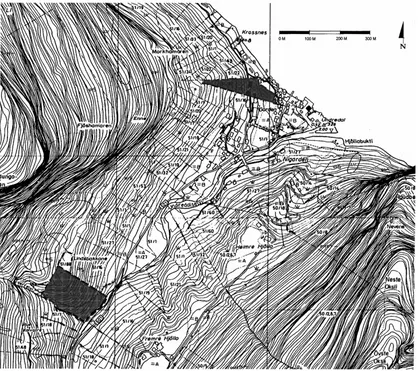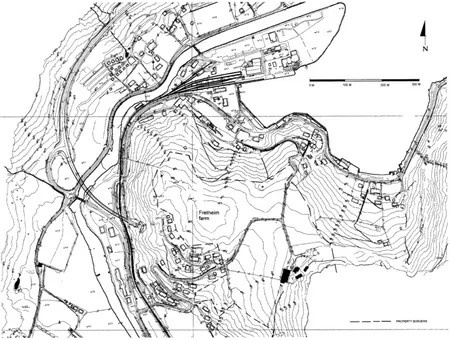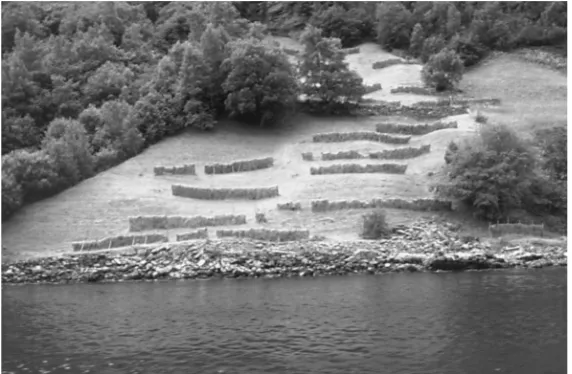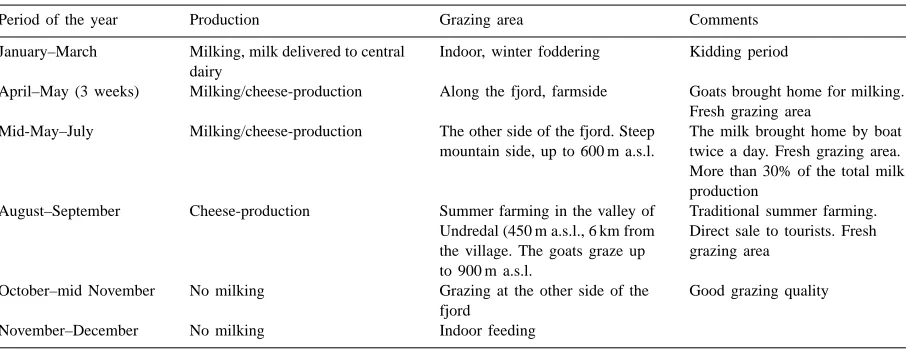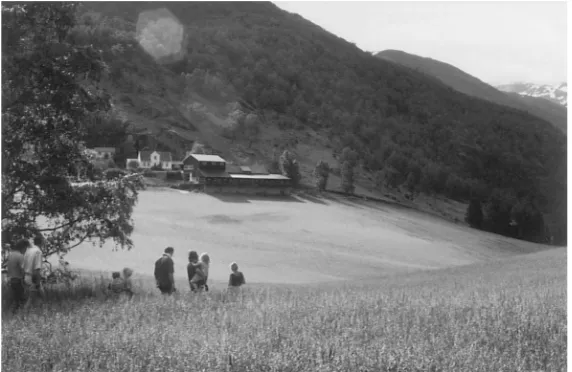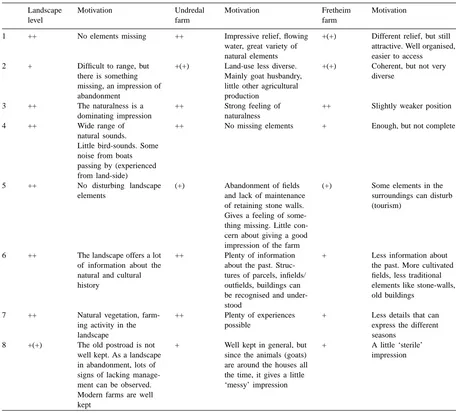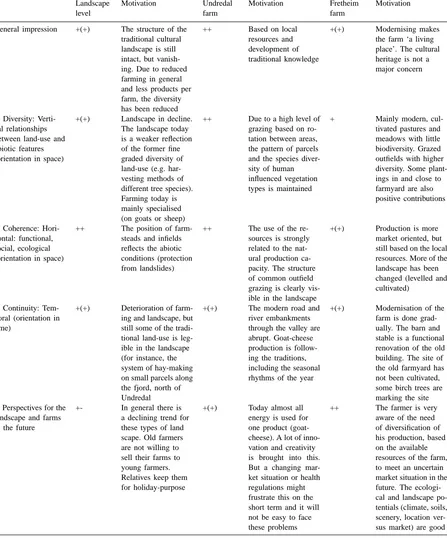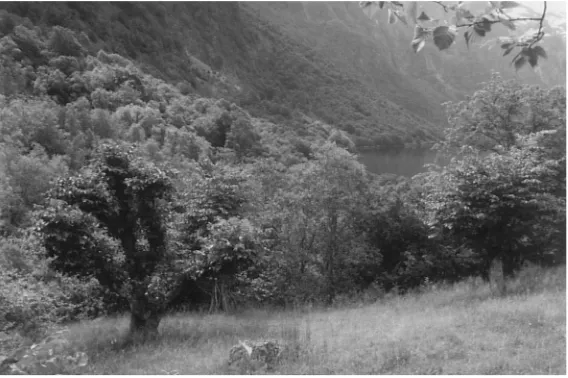The contribution of organic agriculture to landscape quality in the
Sogn og Fjordane region of Western Norway
Morten Clemetsen
a,∗, Jim van Laar
baDr. scient, Fjordsenteret, 5745 Aurland, Norway
bWageningen Agricultural University, Leerstoelgroep Biologische Bedrijfssystemen, Haarweg 333, 6709 RZ Wageningen, The Netherlands
Accepted 19 July 1999
Abstract
To substructure the hypothesis that ecological agriculture positively contributes to landscape quality, a methodology has been developed that evaluates a broad range of components of the cultural landscape based on sets of objective and subjective criteria. This methodology aims to be a feasible regional planning tool Europe-wide and has subsequently been tested and improved in several European regions, the latest in Western Norway. This article presents the results of the farm and landscape quality assessments by an international group of experts of various disciplines and its possible implications for regional planning in a specific local situation. In an interdisciplinary approach two different organic farms in the impressive Norwegian fjord landscape were comparatively studied, especially with respect to their contributions to landscape quality, with emphasis on sensorial perceptions (subjective appreciation) and landscape identity issues (objective appreciation). Moreover, the preservation of values at landscape level as well as the meaning of the cultural landscape values for the local population are discussed. Landscape qualities in the study area are related to nature and cultural heritage values, but these values are declining without active human involvement. The methodology as developed so far appeared useful in demonstrating the values of the landscape and elements in the region to different stakeholder groups, especially with respect to local and regional planning processes. Both the organic farms, as part of the landscape, provide important contributions to the cultural and ecological values of the landscape, but according to the assessment results these contributions are different in quality. ©2000 Elsevier Science B.V. All rights reserved.
Keywords: Ecological agriculture; Goat farming; Landscape assessment; Landscape values; Regional planning; Western Norway
1. Introduction
In the framework of the EU Concerted Action ‘Landscape and nature production capacity of or-ganic and sustainable types of agriculture’ a 5 days’ subgroup meeting took place in Aurland, Western Norway, in the summer of 1997. Scientists of the
Con-∗Corresponding author.Tel.: +47-57633629; fax: +47-57633378 E-mail address: [email protected] (M. Clemetsen)
certed Action’s working group and local landscape and agricultural experts discussed a methodology to assess the rural landscape quality as it was developed in the Concerted Action.
This article deals with the results of these assess-ments on landscape level and, based on a compari-son between the two visited ecological farms, on farm level. Finally, the feasibility of a checklist with sets of criteria’s and parameters as a general tool in landscape planning and agricultural practice will be discussed.
2. Goals and methods
The meeting’s main goal was to test the checklist as mentioned in Section 1 in a specific European ru-ral landscape for its feasibility in evaluating landscape quality on farms (van Mansvelt, 1997; Stobbelaar van Mansvelt, 1999; Rossi and Nota, 2000). More specif-ically, it was aimed to investigate in what ways the checklist could be used as a tool for identifying key issues useful in further planning on landscape and on farm level.
The investigations were based on field observations made at two selected ecological farms in Undredal (Undredal farm) and Flåm (Fretheim farm), respec-tively and on one excursion to the Nærøyfjorden area to observe landscape features. Local experts were in-volved in order to discuss the feasibility of the check-list and to provide local data, general information and feed back. The research must be seen as a rapid rural appraisal.
On location, the two farmers informed the expert group and showed the relevant parts of their farms. Some literature on the Undredal farm was already available. The description of the ‘Fretheim farm’ near Flåm is mainly based on information given by the farmer family and local experts during the visit. The Nærøyfjorden area was visited partly by boat and partly on foot.
The impressions and information collected during the field visits were discussed in group sessions af-terwards, in which subjective appreciation (column 5 of the general checklist, van Mansvelt, 1997) and ob-jective appreciation (column 6 of the general check-list, van Mansvelt, 1997) of the landscape were the main issues to discuss in the context of the following key-questions:
1. How sustainable is the landscape?
2. What are the contributions of the farms to land-scape values?
3. The region
3.1. Geography, geology and climate
Sognefjorden is the largest fjordsystem in Norway, covering an area of more than 10,000 km2. The main fjord has a total length of 200 km. The Aurlandsfjorden
and Nærøyfjorden are two of the innermost southern branches.
The Sognefjorden area is situated in the southern part of the Sogn og Fjordane County, and includes 12 municipalities with an estimated population of 40,000 people.
Results of glacial activity of 20,000 years ago is clearly visible in the landscape like U-shaped fjords and valleys and large plateau’s consisting of moraine deposits in the lower parts of the valleys.
The climate is shifting from humid near the coast to a dry and slightly continental climate in the in-ner parts of the fjord area. The precipitation varies from 4000–5000 mm annually near the ocean to 400–500 mm in some of the deep eastern valleys (Figs. 1–3).
3.2. Landscape features
The landscape has a natural appearance, with char-acteristic features like fjord arms, steep mountains up to 1800 m above sea-level, glaciers, rivers, waterfalls and forests. Small scale cultural landscapes with clus-ters of farms are spread out along the shoreline and in river valleys. In some areas the traditional settlement patterns and the cultivation systems are still rather in-tact, and are now a major part of the tourism attrac-tions of the area.
3.3. Agriculture in western Norway
The conditions for agriculture are limited in the landscape of Sogn og Fjordane County. Not more than 2.5% of the total area is in agricultural use, i.e., 46,000 ha. Agricultural land is scattered in patches along the fjords and lower parts of the valleys, of which 95% of it is permanent or semi-permanent grassland and pasture (see Fig. 4).
Fig. 2. Geography of Undredal farm and its surroundings.
In spite of less favourable conditions for farming, al-most 14% of the population in the county is employed in agriculture. The national average is less than 6%. There are 5500 farmers in the county, 1750 of them are full time farmers. The number of farmers is show-ing a declinshow-ing trend of 1–2% per year. The average size of farms is 7.6 ha of private cultivated land.
3.4. Agricultural support system in Norway
Since the 1970s, agricultural policy in Norway has been based on concentration of cattle, goats and sheep production in western Norway and cereal production in the central eastern region.
In recent years, there has been a shift from bulk production based support to acreage based support. In general this was meant to improve landscape and environment. But at the same time adjustments to EU and world market competition have led to re-ductions in direct agricultural support to farmers over the last 3 years with about 20% and mar-ket prices have been frozen or reduced (Nestande, 1997).
Fig. 3. Location of the Fretheim farm.
3.5. Ecological farming in the region
At the moment there are more than thousand certi-fied organic farms in Norway. The number increases by about 300 new farms per year. In 1996, 4650 ha had been certified as organic, and another 3300 ha were in conversion. Ecological farming is supervised by a na-tional certification body (called DEBIO), which cov-ers both organic and bio-dynamic farms.
In Sogn og Fjordane county there are 70 organic farms land in conversion, with 420 ha of registered infield land. The farms are small and in general the production is based on raising sheep and goats. There is very little milk production for consumption, due to the lack of a distribution system in the region.
Con-sequently, main products are meat and cheese. Also some vegetable and fruit production occurs.
Organic farming is generally regarded to have a positive effect on bio-diversity. A recent comparative study made on three conventional and three converted farms in Sogn indicates that there are differences be-tween farms in this region in terms of the level of bio-logical diversity on farms and number of plant species in meadows (Bøthun et al., 1996).
Fig. 4. Hay-making along the Aurlandfjorden is a labour-intensive activity.
level, mainly ecological milk and meat products can be observed now.
3.6. Aurland and its economy
The municipality of Aurland is covering an area of 1489 km2, including 70 km2of fresh water. Eighty per-cent of the land is higher than 900 m above sea-level. The municipality has about 1850 inhabitants, mainly living in the four villages: Aurland, which is the ad-ministration centre, Flåm, Undredal and Gudvangen. The local economy is still based on farming and some small industry, but the main economic income is gen-erated from hydro-electric power production and a growing international tourism industry. Tourism has become more and more important in the last decades. Today at least 600,000 persons are visiting Aurland each year, most of them on day-trips in the months between May and September. The combination of out-standing natural and scenic qualities and a living cul-tural landscape is without doubt the most important experience offered to the visitor.
Approximately 100 farms are still in practice in Aurland, but their number is decreasing every year. Live-stock production is based on low input grazing of extensive resources in the common outfields. Six farms (63 ha, nearly 10%) have been certified as or-ganic or are in conversion. Sheep and goat farming
are dominant. Aurland belongs to the municipalities with the highest numbers of goats in Norway. Next to live-stock raising, there is also some fruit, berry and vegetable production.
Reindeer-and deer-hunting have ancient traditions in Aurland and still play an important role in the local economy and social life. Formerly, salmon and trout fishing was an important income-source for the farms, but are at present of less economic importance.
3.7. Local landscape management strategies in Aurland
Different strategies to support local landscape man-agement initiatives are being discussed in Aurland at the moment. Development of high quality farming products based on local traditions is one important way to make the farms competitive. Other initiatives in-clude direct involvement from interested persons and voluntary groups from outside. The conditions for con-version to ecological farming in terms of production and economy are regarded as good and many farmers are now encouraged to start the conversion process. The School for Ecological Farming in Aurland is an important source of inspiration in this process.
4. The study area
4.1. Nærøyfjorden and Aurlandsfjorden
The landscape area that surrounds the two fjord branches (Fig. 1) is of high scenic beauty with a dra-matic relief. The steep mountain slopes are covered with a variety of deciduous trees, like Birch (Betula verrucosa), Alder (Alnus incara), Hazelnut (Corylus avellana), Elm (Ulmus glabra), Ash (Fraxinus excel-sior), Lime tree (Tilia spp.) and herbs. Old settlements are found mainly in the lower parts along the fjord or on mountain plateaus. Along the fjord active cultiva-tion and harvesting can be observed, but only a few farms are still in practice. Formerly, the land-use sys-tem has been dominated by grazing, hay-making and pollarding of trees. Nowadays, the agricultural activity has decreased to a minimum level and the characteris-tic traditional cultural landscape is about to disappear. The landscape also contains many important heritage monuments and cultural elements, like the old post-man’s road from the 17th century, which has recently been restored. Parts of the Nærøyfjorden area has been designated as a nature reserve. Here traditional tree management was reintroduced, carried out by students of the School for Ecological Agricultural in Aurland. Local farmers have also been involved through man-agement agreements to keep some parts of the land-scape open by making hay and by animal grazing. Woods are a restricted and regulated resource for in-stance used for the famous brown cheese production. The whole Nærøyfjorden, most of Aurlandsfjorden and the surrounding mountain plateau’s are in the
pro-cess of being designated as a ‘Landscape Protected Area’ and moreover, the area has been nominated for the UNESCO World Heritage List as a landscape of outstanding geological significance, natural beauty and with unique farming traditions.
4.2. Characteristics of the Undredal farm and its surroundings
4.2.1. The village and surrounding landscape The community of Undredal has 120 inhabitants, and 10 farm units are still in practice. Originally there used to be 20 farms in Undredal. The average size of the infields belonging to the farms is less than 5 ha. The production on six farms is based on goat farming and cheese production. On four farms, sheep raising is combined with other sources of income. Fruit and veg-etable production is also done on some of the farms. Undredal can be reached by car since 1988. Till then, boats were the only way of transportation.
Two summer farms, that are only used during the growing season by goat farmers, are situated in the Undredalen valley. The connection to the main road system makes it easier for the farmers to reach the summer farms, which are located along the road. Old pastures are kept open by animal grazing and by cut-ting of firewood for the cheese-making process. These activities contribute to the conservation of character-istic diversity of species in human-influenced vege-tation types (also see: Austad, 1988; Austad et al., 1993). Soil types around Undredalen belong mainly to Rankers (Umbric Regosols), Lithosols and Orthic Podzols, according to the FAO soil classification 1974.
4.2.2. The farm
The only ecological goat farm in Undredal started the conversion process by the end of the 1980s (Fig. 2). The woman farmer is responsible for the farm. Her husband is currently working full-time outside the farm. The live-stock represents 45 milking goats, hens, two horses and a few pigs.
goats and their kids. Inside, additional proteins from fish products, sea-weed and cereals (barley, oats) are stored and will be fed to the goats when necessary. There is some horticulture production.
There are two summer farms in regular use by all the goat farmers in Undredal; one in Melhus, located 3 km upstream in the Undredalen valley, and the other is Langhuso, 3 km further on.
4.2.3. Economy of the farm
During the field visits, milking of goats and the production of the cheese took place in the modern stable at Melhus, about 3 km outside Undredal. The milking process is mechanised. Six goats can be milked at the same time. The cheese production takes place in big metal tubs which are heated with fuel-wood of Alder (Alnus sp.). One horse chart load of wood is sufficient for 2 days of energy supply. After evaporation, the cheese is taken out and put into lit-tle wooden boxes, containing 1.5–2.0 kg of cheese. The light-yellow unboiled cheese is considered as a by-product. The famous regional goat cheese has a caramel like colour. Seasonal young workers assisted in milking and cheese production. Here, 40 goats pro-duce 22,000 l per year. 14,000 l is being delivered, the rest is being used for home-made cheese production. It seems that inappropriate hygienic regulations from the national health authorities has been a problem for this kind of local production. Norwegian small scale cheese producers are now working hard to find acceptance for more appropriate regulations.
As a conclusion, ecological farming and a certain amount of extra income from tourism provide for the means of subsistence. Besides, the female farmer’s innovative enthusiasm contributes to successful goat farming in Undredal.
4.2.4. The society of Undredal
The cheese-production on the summer farms is a key factor to the farm economy, but is also an impor-tant part of the identity of the society as well. The people in the village of Undredal are proud of their brown and white goat cheese which is produced from May until the end of September. Summer farming in-volves the farmers socially and personally in an activ-ity which have important effects both in maintaining traditional knowledge and in developing new
produc-tion techniques. As a result of a local development project, the farmers have founded a co-operative or-ganisation for marketing and sale of the cheese prod-ucts. Concerning this, there is no distinction between the ecological farm and the conventional ones.
4.2.5. The fields
Four hectares of private cultivated fields are mainly located in the lower part of the Undredalen valley, and on terraces of glacifluvial moraine deposits at an alti-tude of 150 m above sea-level. Some meadows along the fjordside are still in use on places only accessible by boat. From the settlements, the mountain slopes rise up steeply to 900 m, where the fertile summer pastures for sheep can be found.
In order to produce enough hay, some fields-covering totally 10 ha are rented. One field had a very steep topography. Hay-making under these conditions in-cludes a lot of labour with low yields. Light mowing machines, as well as a scythe are used. After collect-ing, the hay is mainly transported by horse traction and to a lesser extent by two-wheel tractor and is sub-sequently stored. Solid manure as traditional fertiliser has been reintroduced.
A hayfield nearby, located on a natural terrace and former arable land (Fig. 5) had a rather flat topog-raphy and some improvements have been carried out like ploughing, removing boulders (in 1982) and using better producing grass species and clover, all aimed at obtaining good yields of hay. An avalanche disturbed one of the irrigation tubes in the winter of 1997, but did not harm the fields.
Since the in-fields are so limited in size, the working rhythm on the farm is more related to the continuous shifting of grazing and milking places than the work-ing operations on the cultivated fields. Grazwork-ing goats and sheep and to some extent hay-making, is the only possible way of using the vast outfield resources for agricultural purposes.
Fig. 5. Managed and improved pastures belonging to the Undredal goat farm.
Table 1
The seasonal cycle of goat farming at the Undredal organic goat farm
Period of the year Production Grazing area Comments
January–March Milking, milk delivered to central dairy
Indoor, winter foddering Kidding period
April–May (3 weeks) Milking/cheese-production Along the fjord, farmside Goats brought home for milking. Fresh grazing area
Mid-May–July Milking/cheese-production The other side of the fjord. Steep mountain side, up to 600 m a.s.l.
The milk brought home by boat twice a day. Fresh grazing area. More than 30% of the total milk production
August–September Cheese-production Summer farming in the valley of Undredal (450 m a.s.l., 6 km from the village. The goats graze up to 900 m a.s.l.
Traditional summer farming. Direct sale to tourists. Fresh grazing area
October–mid November No milking Grazing at the other side of the fjord
Good grazing quality
November–December No milking Indoor feeding
The same happens to the milk twice a day. On the slope, lime trees (Tilia sp.) grow and their leaves are grazed by the goats as good fodder. The carrying ca-pacity does not exceeded, since natural erosion of the rocks provides for new minerals.
According to the farmer’s family, maintenance and even extention of the traditional use of the outfield resources has been essential for the result of the conversion process. By extending the grazing period (see Table 1), the level of added concentrates could be kept within acceptable limits without reduction of the amount of milk produced (Clemetsen and Kerner,
1992). From the beginning of April until November the goats are systematically grazing the surround-ing outfields of the farm (see Table 1). In this way, the milk goats will always have access to fresh and tasteful, energy-rich fodder.
4.3. Characteristics of the Fretheim farm
4.3.1. The surrounding landscape
Fig. 6. The Fretheim farm operates as an organic mixed farming system in the Flåm Valley.
Flåm valley. Originally there were 13 ‘named farms’ (including Fretheim) in the Flåm valley (Indrelid, 1988). Each farm was divided into several separate family holdings and cotter’s places. Today 20 of these units are in production. One of them is the Fretheim farm, converted to ecological agriculture quite re-cently (Fig. 3). Now that the number of sheep in general has decreased, the vegetation on the slopes has changed. An increase of tree vegetation, mainly birch (Betula spp.) woodlots, can be observed.
4.3.2. The farm
The farm is located at the inner end of the Au-rlandsfjorden, close to the tourism village of Flåm and just outside the borders of the designated Land-scape Protected Area. The farmyard and major parts of the infield are situated on a plateau of moraine and marine deposits, belonging to the Dystric Fluvisols, Cambisols and Lithosols in terms of the FAO soil clas-sification 1974. The high degree of clay soils is rather seldom in this region and provides the infield with a high level of natural fertility. A young family took over the farm in 1991 and started conversion to eco-logical agriculture in 1993. The whole farm was cer-tified organic in 1997. The farm has belonged to the same family since the 17th century. The farmyard was moved to a better location after a land consolidation process in the last century. Remains of the old
farm-yard are still perceptible in the landscape. The place is surrounded by a woodlot of old pollarded birch trees and represents an important visual element in the farm landscape. The Fretheim farm can be characterised as a mixed, organic farm with live-stock, grass land, arable land and horticulture, grazed wood pastures and com-mon, extensively grazed lands, the so-called ‘utmark’ (see Fig. 6).
4.3.3. Economy of the farm
The infields represent 12 ha, which is above the av-erage in the area. In the adjacent hillside 200 ha of rather steep and wooded pastures are used for ani-mal grazing in spring and autumn. 1500 ha of moun-tain pastures (outfields) are grazed by sheep during 3 months in the summer. The total grazing period is 20 weeks. More than 40% of the fodder comes from graz-ing on natural pastures. The production on the farm consists of sheep, a few beef cattle, 0.3 ha of horticul-ture and fruit growing. The income of the family is generated from activities related to the farm.
Table 2
Differences in motivation and strategies in ecological farming
Undredal farm Fretheim farm
Main approach to ecological farming Ideological Pragmatic Farmer’s motivation Ecological goat farming is the only
possible alternative. Aiming at reaching an ecological and economical optimum within the production
Ecological farming as common sense: the best way of getting an economic return from the farm
Strategies for diversification in order to meet changes in future market situation
Continuity: developing traditional, existing knowledge, based on stability in the market
Trying out and making improvements on a wider range of products
Highly specialised knowledge giving a unique position in todays market
Building up a broader knowledge of what is possible to produce on the farm. Creativity towards uncertain market situation
based on grass for silage. The soils consist mainly of clay.
In June, 150 sheep graze in the mountains, which are very important for summer grazing. The sheep meat is approved for organic meat. The farmer and his wife have started to build up a beef cattleherd. At the time of the farm visit they had one grown-up cow and three young cows.
Oats and peas are grown for silage and the same counts for grass. The products from the fields are used for winter fodder. The farmers consider traditional hay-making to be too labour intensive. In their opin-ion, it is quite easy to obtain reasonable yields in or-ganic farming on the property, because the cold winter kills crop affecting insects. The birch woodlots on the slopes are used for firewood.
Today tourist rental of two recently built cabins along the fjordside is an important part of the income of the farm. In addition there is some income from salmon fishing in the river.
4.3.4. Pressure
The property meets continuous stress due to expan-sion in nearby tourism facilities and tunnel construc-tion. But the location also offers opportunities for extra financial income to the farm’s economy. The farmyard and major parts of the infields are situated on a plateau of moraine and marine deposits. The high degree of clay soils is rather seldom in this region and provides the infields with a high level of natural fertility. Still, there is no need for irrigation-which in general is nec-essary in the area-, but since a road tunnel was con-structed underneath the fields some 10 years ago, the soils have rather dried out due to the drainage effects.
This is observed as a problem, but so far there is no need for irrigation.
4.4. Comparison between the two farms
Both the Undredal and the Fretheim farms have suc-ceeded in converting to ecological farming, but they appear different in terms of farming motivation and farm strategies. This has been described in Table 2.
5. Results of the assessment studies
Three expert subgroups were dealing separately with the three main issues of the checklist: the qual-ity of the (a)biotic environment, the qualqual-ity of the social environment and the quality of the cultural environment. In this article emphasis has been laid on columns 5 and 6 concerning the quality of the cultural environment. The results are presented and elaborated in detail in Tables 3 and 4.
5.1. Sensorial perceptions (Table 3)
Questions were used to structure the research of subjective and sensorial perceptions (Kuiper, 1997; Kuiper, 2000; Stobbelaar and van Mansvelt, 2000):
1. What is your appreciation of the natural environ-ment like relief, water, soil and climate?
2. What is your appreciation of the land use? 3. What is your feeling about the naturalness? 4. Do you like the range of sensorial information like
colours, smells and sounds?
Table 3
Assessment of subjective appreciation of the landscape (++ = best,−−= lowest)
Landscape Motivation Undredal Motivation Fretheim Motivation
level farm farm
1 ++ No elements missing ++ Impressive relief, flowing water, great variety of natural elements
+(+) Different relief, but still attractive. Well organised, easier to access 2 + Difficult to range, but
there is something missing, an impression of abandonment
+(+) Land-use less diverse. Mainly goat husbandry, little other agricultural production
+(+) Coherent, but not very diverse
3 ++ The naturalness is a dominating impression
++ Strong feeling of naturalness
++ Slightly weaker position
4 ++ Wide range of
++ No missing elements + Enough, but not complete
5 ++ No disturbing landscape elements
(+) Abandonment of fields and lack of maintenance of retaining stone walls. Gives a feeling of some-thing missing. Little con-cern about giving a good impression of the farm
(+) Some elements in the surroundings can disturb (tourism)
6 ++ The landscape offers a lot of information about the natural and cultural history
++ Plenty of information about the past. Struc-tures of parcels, infields/ outfields, buildings can be recognised and under-stood
+ Less information about the past. More cultivated fields, less traditional elements like stone-walls, old buildings
7 ++ Natural vegetation, farm-ing activity in the landscape
++ Plenty of experiences possible
+ Less details that can express the different seasons
8 +(+) The old postroad is not well kept. As a landscape in abandonment, lots of signs of lacking manage-ment can be observed. Modern farms are well kept
+ Well kept in general, but since the animals (goats) are around the houses all the time, it gives a little ‘messy’ impression
+ A little ‘sterile’ impression
5. Do you get a feeling of unity in the landscape?
– are any landscape components missing?
(com-pleteness)
– are any landscape components disturbing?
(wholeness)
6. Does the landscape give information (or sensa-tions) about the past?
– which elements?
7. Does the landscape offer you experiences of the seasons?
8. Is the landscape well-kept?
5.2. Landscape identity (Table 4)
The questions used for evaluating the objective landscape identity are listed below. From the main question that is related to the general impression of the landscape four subquestions are posed.‘Does the arrangement of landscape components express the natural heritage, the cultural heritage and the present meaning?’
Table 4
Assessment of objective appreciation of the landscape (++ = best,−−= lowest)
Landscape Motivation Undredal Motivation Fretheim Motivation
level farm farm
General impression +(+) The structure of the traditional cultural landscape is still intact, but vanish-ing. Due to reduced farming in general and less products per farm, the diversity has been reduced
++ Based on local resources and development of traditional knowledge
+(+) Modernising makes the farm ‘a living place’. The cultural heritage is not a major concern
+(+) Landscape in decline. The landscape today is a weaker reflection of the former fine graded diversity of (on goats or sheep)
++ Due to a high level of grazing based on ro-tation between areas, the pattern of parcels and the species diver-sity of human influenced vegetation types is maintained
+ Mainly modern, cul-tivated pastures and meadows with little biodiversity. Grazed outfields with higher diversity. Some plant-ings in and close to farmyard are also
++ The position of farm-steads and infields related to the nat-ural production ca-pacity. The structure of common outfield grazing is clearly vis-ible in the landscape
+(+) Production is more market oriented, but still based on the local resources. More of the landscape has been
+(+) Deterioration of farm-ing and landscape, but still some of the tradi-tional land-use is leg-ible in the landscape (for instance, the system of hay-making on small parcels along the fjord, north of Undredal
+(+) The modern road and river embankments through the valley are abrupt. Goat-cheese production is follow-ing the traditions, including the seasonal rhythms of the year
+(+) Modernisation of the farm is done grad-ually. The barn and stable is a functional renovation of the old building. The site of the old farmyard has not been cultivated, some birch trees are marking the site 4. Perspectives for the
landscape and farms in the future
+- In general there is a declining trend for these types of land scape. Old farmers are not willing to sell their farms to young farmers. Relatives keep them for holiday-purpose
+(+) Today almost all energy is used for one product (goat-cheese). A lot of inno-vation and creativity is brought into this. But a changing mar-ket situation or health regulations might frustrate this on the short term and it will not be easy to face these problems
components express the relationship between the land-use and the abiotic features?’
2. Coherence (horizontal coherence in favour of ori-entation in space): ‘Does the arrangement of land-scape components and patterns reflect the abiotic features?’
3. Continuity (temporal coherence in favour of orientation in time): ‘Does the arrangement of landscape components reflect (passive) and/or correspond with (active) the cultural heritage?’ 4. Potentials: ‘Imagine what the landscape will look
like in 20 years and are there any indications of continuation in the future?’
6. Discussion
6.1. Feasibility of criteria and parameters
The discussion is directed at the feasibility of crite-ria’s and parameters of column 5 and 6 of the general checklist. Perception and evaluation are considered context related: the farms are evaluated in compari-son with each other and with the landscape/regional situation. This means that the Fretheim farm perhaps would have been ranked higher if evaluated with a randomly chosen farm. The visit to the Fretheim farm has been restricted to the infields around the farm. The surrounding outfields and landscape were not deeply investigated.
To some extent it was felt difficult to separate the personal, subjective approach in column 5 from the objective one in column 6. A reason might be that it is difficult not to use one’s ‘professional eyes’ in col-umn 5.When comparing different farms in a region like Sogn, it appears difficult in using the checklist to rank them. Most farms are more or less in the same situa-tion, whether they are ecological or not. In many sit-uations, like Undredal, the single farms are so closely related to each other (e.g. the summer farming sys-tem) that it is justified to evaluate the whole farming system of the village.
The general impression is that column 5 and 6 func-tion well as a basis for communicafunc-tion between pro-fessionals to provide a common understanding of a specific landscape situation. However, the criteria can
be understood more easily by formulating questions as demonstrated in Section 4.2.
The landscape and farm assessments in Aurland offered new views on the feasibility of the con-certed action’s method, especially regarding to the implementation of the criteria’s to local and regional landscape planning and management strategies. The method as developed so far can be of basic use in defining problems and finding solutions from a more holistic approach. This should be of interest for the local community, which will not accept a pure con-servation regime in the fjord. The future of local communities in the fjord area will be dependent on a planning process that includes a dynamic integra-tion of both conservaintegra-tion and economic progress, based on the existing broad range of natural, cul-tural and social resources is required. The checklist appears to be especially useful in a ‘rapid rural appraisal’.
The importance of the checklist, especially column 6, as a tool for identifying essential issues for future planning and development of a region was discussed. To make these essential issues clear, questions should be posed on the potential developments related to the natural environment, cultural (heritage) environ-ment and the existing social structures for future de-velopment as given in Table 4. Identification of key issues can be used in planning of future develop-ment of the Nærøyfjorden area and in other regions as well. The following questions might be helpful with that:
• What are the values of the landscape? • Who are the beneficiaries of these values? • What are the threats of these values?
• How can these values be preserved and developed?
This set of questions might give an additional tool in regional landscape planning, especially when all stakeholders are consulted.
7. Recommendations
threats in a local or regional context is needed among the several persons and institutions involved. This is also useful for the development of political strategies on regional and local levels for landscape conservation and economic development as a part of local planning processes. Participation and empowerment in planning through the concept of ‘Local Agenda 21’ is currently given high priority. Implementation of the method de-veloped by the Concerted Action in conservation and development plans on municipal or landscape level, can, therefore, trigger economic support from national and regional authorities.
The future of the Nærøyfjorden as an agricultural landscape depends on finding creative ways of using the natural resources in agricultural production, for instance co-operative initiatives for the use of aban-doned pastures and wood-pastures or keeping grazing animals during the summer period.
8. Conclusions
The landscape and farm assessments in Aurland of-fered new views on the feasibility of the checklist, especially regarding to the implementation of the cri-teria’s to local and regional landscape planning and management strategies. Based on the assessments de-scribed in this article, some conclusions can be drawn both on landscape level and on farm level. These con-clusions are related to the key-questions:
– Is the landscape sustainable?
– What are the contributions of the farms to landscape
values?
8.1. Landscape level: Nærøyfjorden
Landscape qualities of the Nærøyfjorden are related to nature and cultural heritage values. However, there are few signs of destructive land-use like modern roads that do not fit into the landscape scenery or have a negative influence on nature. The cultural elements like the old post-road should be kept in a better con-dition. There are clear evidences of abandonment of farms and dereliction of the traditional cultural land-scape. Consequently, the Nærøyfjorden as a cultural landscape can not be regarded sustainable under the present conditions. Diversity is declining and
conti-nuity will disappear. Most people living in the fjord are old and nobody within the family is willing to take over as a farmer. There are very few signs of progress.
The future of the Nærøyfjorden is a matter of ac-tive involvement. A passive attitude might lead to total abandonment of the land and then the fjord will only be used for transportation of tourists. Here it must be added that even without any human activity in the re-gion, the fjord will still be impressive and unique as a natural scenic attraction. However, this scenario is hardly politically acceptable, because of the integrated values of man–nature relations in this Landscape Pro-tected Area. Both the conservation authorities and the tourism industry are involved in planning for the fu-ture of the fjord system which requires a certain level of traditional activities in the fjord (see Fig. 7). There is an urgent need for appropriate planning tools to ini-tiate sustainable development.
8.2. Farm level
It is quite obvious that both the farms make impor-tant contributions to the cultural qualities of the land-scape. Both farms keep parts of the fjord landscape open and provide for landscape variety. According to Tables 3 and 4, the Undredal farm contributes more to landscape quality in both the subjective and objective sense than the Fretheim farm, because of better scores on some of the sensorial criteria and for diversity and coherence. For instance, the local cheese production in Undredal contributes to the spatial and experien-tial diversity of the landscape. It is also important for aestethic, visual and other sensorial perceptions, like the smell of goats and cheese on the farm landscape. Goat farming is of great importance for the quality of the landscape in the study area.
Fig. 7. Traditional tree management and wood pasture along the Nærøyfjorden are reintroduced to maintain cultural and ecological values.
Consequently, the contributions of the two farms to the landscape quality are both positive but different, which depends much on the personal strategy of the farmers as described in Table 2.
Acknowledgements
The last Subgroup Meeting of the Concerted Action was held from 12 to 17 July 1997 in Aurland, Sogn and Fjordane, Norway and was organised by Dr Morten Clemetsen. Accommodation and meetings were in the School for Ecological Agriculture and Horticulture. The following members of the Concerted Action par-ticipated: Morten Clemetsen (Norway), Thomas van Elsen (Germany), Jim van Laar (the Netherlands), Jan Diek van Mansvelt (the Netherlands), Finnain Mac-Neidhe (Ireland), Roberto Rossi (Italy), Kees Volker (the Netherlands). Experts from Norway who joined the meeting (partly) were: Anders Anderssen, County Governor of Sogn and Fjordane; Maria Bjune, direc-tor of the School for Ecological Agriculture, Aurland; Anne Elgersma, Norwegian Institute of Land Inven-tory, Ås; Anne Karin Hatling, School for Ecological Agriculture, Aurland; Eli Heiberg Sogn and Fjordane College, Department of Landscape Ecology, Sogn; Karl Kerner, Agricultural University of Norway, Ås; Nat Mead, School for Ecological Agriculture,
Aur-land; Christian Zurbuchen, Advisory service for eco-logical farmers in Sogn.
References
Austad, I., 1988. Tree Pollarding in Western Norway. In: Birks, H.H., Birks, H.J.B., Kalard, P.E., Moe, D. (Eds.), The Cultural Landscape Past, Present and Future, p. 13–29, Cambridge University Press.
Austad, I., Hauge, L., Helle. T., 1993. Maintenance and conservation of the cultural landscape in Sogn og Fjordane, Norway. Final report. Department of Landscape Ecology, Sogn og Fjordane College, p. 60.
Bøthun, M., Gladsø, J.A., Røysum, M., 1996. Bio-diversity in the agricultural landscape-a comparative study between ecological and conventional farming. Sogn og Fjordane College, Sogndal, p. 115 (in Norwegian).
Clemetsen, M., Kerner, K., 1992. Outfield resources and landscape exerience (Utmaksressurser og kulturlandskap). Rapport 8. 30-bruks prosjektet NORSØK, Tingvoll. Report, p. 35 (in Norwegian).
Indrelid, S., 1988. The Farming system and its History in the Flåm Valley, Western Norway. In: Birks, H.H., Briks, H.J.B., Kalard, P.E., Moe, D. (Eds.), The Cultural Landscape Past, Present and Future, pp. 11–45, Cambridge University Press.
Kuiper, J., 2000. A checklist approach to evaluate the contribution of organic farms to landscape quality. Agric. Ecosyst. Environ. 77, 143–156.
Nestande, E., 1997. Agricultural Support In Norway, The County Governor of Sogn og Fjordane, p. 4 (unpublished).
criteria and parameters in two Tuscan farm-landscape. Agric. Ecosyst. Environ. 77, 53–64.
Stobbelaar, D.J., van Mansvelt, J.D., 2000. The process of landscape evaluation. Introduction to the 2nd special issue of the Concerted Action: The landscape and nature capacity
of organic/sustainable types of agriculture. Agric. Ecosyst. Environ. 77, 1–15.
